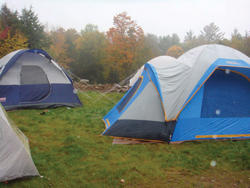Regardless of the season or venue, every camper needs reliable equipment. It is hard for one to find these assets if they are unaware of the options, hence why it is important to any beginning or intermediate camper to find their preference of tent, sleeping bag, and sets of clothes.
The first step towards acquiring the proper tools for a camping trip would be to determine how many people are going to accompany you in the woods. The amount of food, the tent size, and the water supply are determined on the number of people in a group. Secondly, one must finalize their campground. By doing so, one can begin to buy the proper tools. For instance, if a campground has a barbeque set available for the public, there is no need to bring a small grill of your own.
With the figures and site squared away, it is time to choose a tent. There are many different styles of tents, for example, gocamping.org describes a cabin tent, a tunnel tent, and a dome tent. A cabin tent is usually used for large groups or when one is driving to a campground rather than walking. If you are planning to hike on a trail, it is recommended to travel with a very light, small tent or tarp since you will be lugging it around for your entire trip.
A tunnel tent is essentially what it sounds like; the tent appears in the form of a tunnel. Tunnel tents are debatably the easiest tent to pitch (in other words set up) but they can be swayed by the wind much more than other forms of tents.
Lastly, the dome tent has three or more poles making it a sturdy and roomy area. While the choice of style does depend on the camper’s preference, it is important to keep in mind how many people are going on the trip and what the weather will be like.
Scoutbase.org urges people to keep in mind, “When buying a tent – remember to minus one person from the manufacturer’s recommendations. So, a two person tent would be comfortable for one with kit, a three person tent, would be comfortable for two with kit and so on.”
After the proper tent has been purchased, it is time to search for a sleeping bag. Ranging anywhere from $20 to $700 according to Dick’s Sporting Goods store, it is important to keep in mind weather conditions when purchasing a sleeping bag. While it may not be financially advisable to buy the most expensive sleeper, it may not be practical to purchase the cheapest either.
If the trip includes camping in upstate New York in the middle of January, then buy the warmest sleeping bag available but if the trip is planned to be around Monmouth during July, a heavy sleeping bag is not necessary. It may be best to buy a cool sleeping bag that would work in any season and invest in extra wool blankets for the cold seasons.
Wilderness.org also suggests tobring a mat to place between your body and the ground in order to stay even warmer during the fall or winter. This can easily prevent from hypotherma and keep away any unwanted critters.
Professor William Reynolds, advisor to the Outdoors Club, believes there are three crucial fundamentals to bring when camping. “Essentials would be a good light, an appropriate sleeping bag for the weather and changes off clothes along with wool socks,” Reynold said.
Once the sleeping situation is handled, one has to pack the basics for a camping trip. According to wilderness. org, the required accessories for fall camping are: gloves, extra shoes, winter jacket, a tarp, garbage bags, extra blankets, small snacks, canteens, and clean water.
The Outdoors Club President, Greg Cenicola, adds that no matter what season, you must pack a ton of socks. “The most important thing to bring camping is extra socks.” Cenicola said. “If your feet are uncomfortable and get wet, you increase your chance to get either athlete’s foot or trench foot. Socks are the only thing I bring extra of when I do go camping.” Cenicola also noted that one’s feet often get wet since they are close to the ground.
All this information is mainly if one were to go to a campsite. As previously mentioned, if you plan a trip which includes both hiking and camping, you must pack light. This summer, Reynolds hiked part of the Appalachian Trail with the current president and vice president of the Outdoors Club along with the founder of the club, Paul Mandala. Since the four of them hiked as well as camped, it was essential to pack the least possible.
“We had very nice lightweight two man tents and very nice light sleeping bags,” Reynolds recalled about the trip, “[We also had] minimal clothes, freeze dried food and water filters because we had to find brooks and springs and then boil the water.”
Whether hiking is involved or not, there are many aspects that play key parts in packing for a camping trip. Secretary for the Outdoors Club, sophomore Pat Layton, believes that the weather determines everything.
“Always be prepared for rain,” Layton continued. “Never wear cotton because if you do [especially when it rains], you’re going to be uncomfortable.” Professor Reynolds has a different opinion of what the most important aspect is when prepping to camp. “When you prepare to go camping, the most important thing to bring with you is a great attitude and a friend,” Reynolds commented.
Now that you are well aware of how to prepare for a camping trip, it is time to begin your adventure.
PHOTO COURTESY OF Jackie Leming



